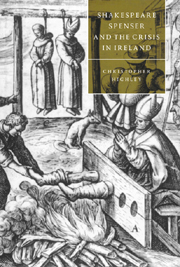Book contents
- Frontmatter
- Contents
- List of illustrations
- Acknowledgements
- Introduction: Elizabeth's other isle
- 1 Spenser's Irish courts
- 2 Reversing the conquest: deputies, rebels, and Shakespeare's 2 Henry VI
- 3 Ireland, Wales, and the representation of England's borderlands
- 4 The Tyrone rebellion and the gendering of colonial resistance in 1 Henry IV
- 5 “A softe kind of warre”: Spenser and the female reformation of Ireland
- 6 “If the Cause be not good”: Henry V and Essex's Irish campaign
- Notes
- List of works cited
- Index
- Cambridge Studies in Renaissance Literature and Culture
6 - “If the Cause be not good”: Henry V and Essex's Irish campaign
Published online by Cambridge University Press: 04 December 2009
- Frontmatter
- Contents
- List of illustrations
- Acknowledgements
- Introduction: Elizabeth's other isle
- 1 Spenser's Irish courts
- 2 Reversing the conquest: deputies, rebels, and Shakespeare's 2 Henry VI
- 3 Ireland, Wales, and the representation of England's borderlands
- 4 The Tyrone rebellion and the gendering of colonial resistance in 1 Henry IV
- 5 “A softe kind of warre”: Spenser and the female reformation of Ireland
- 6 “If the Cause be not good”: Henry V and Essex's Irish campaign
- Notes
- List of works cited
- Index
- Cambridge Studies in Renaissance Literature and Culture
Summary
Sick Ireland is with a strange war possessed
Like to an ague, now raging, now at rest,
Which time will cure, yet it must do her good
If she were purged, and her head-vein let blood.
John Donne, Elegy 20On August 14, 1598 at the battle of the Yellow Ford, Tyrone routed the English and captured the crucial strategic position of the Blackwater fort in Ulster. Then, in October, rebellion spread to Munster, supposedly the most “civil” and obedient area outside the Pale. “This rebellion,” wrote an alarmed council in Dublin, “is now thoroughly sorted to an Irish war, whose drifts and pretences are, to shake off all English government, and subtract the kingdom from Her Majesty.” In response to what seemed like the imminent dissolution of English authority, Elizabeth – construing recent reversals as intolerable blows to her honor – at last seemed prepared to suspend her “wonnted myldnes.” Following the Blackwater debacle, she named Sir Richard Bingham Marshal of Ireland and dispatched him with reinforcements. And, more important, after months of deliberation, she gave the long-vacant viceregency to the Earl of Essex. With what in retrospect seems a pointed irony, the first official confirmation of his appointment was made the day before Spenser's death in London on January 13, 1599. During the Munster revolt the insurgents had burnt Spenser's home at Kilcolman, forcing him to flee with his family, first to Cork where he joined other displaced planters, and then to London where he was sent with letters from Sir Thomas Norris, the provincial president, to the English Privy Council.
- Type
- Chapter
- Information
- Shakespeare, Spenser, and the Crisis in Ireland , pp. 134 - 163Publisher: Cambridge University PressPrint publication year: 1997
- 1
- Cited by



